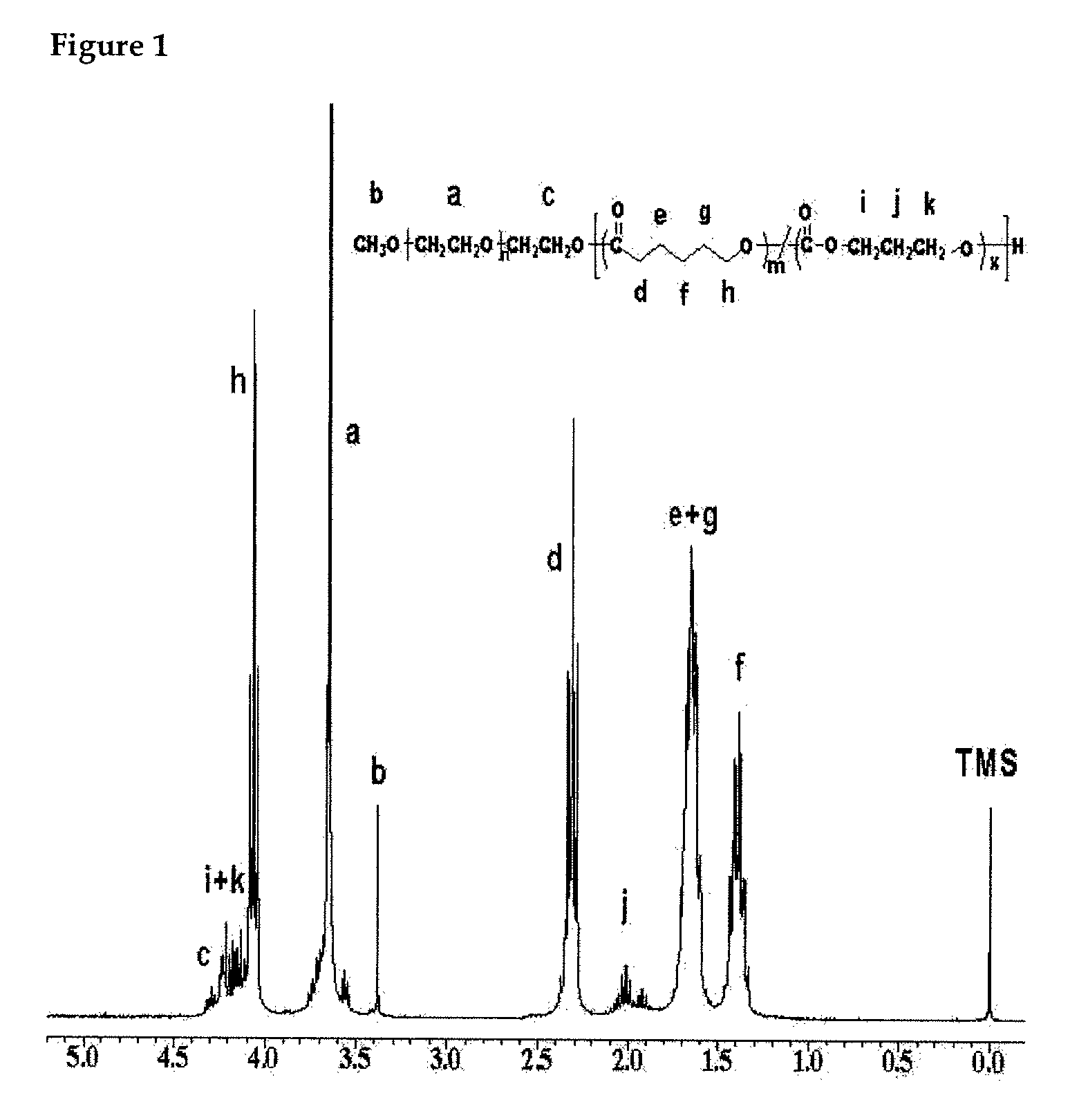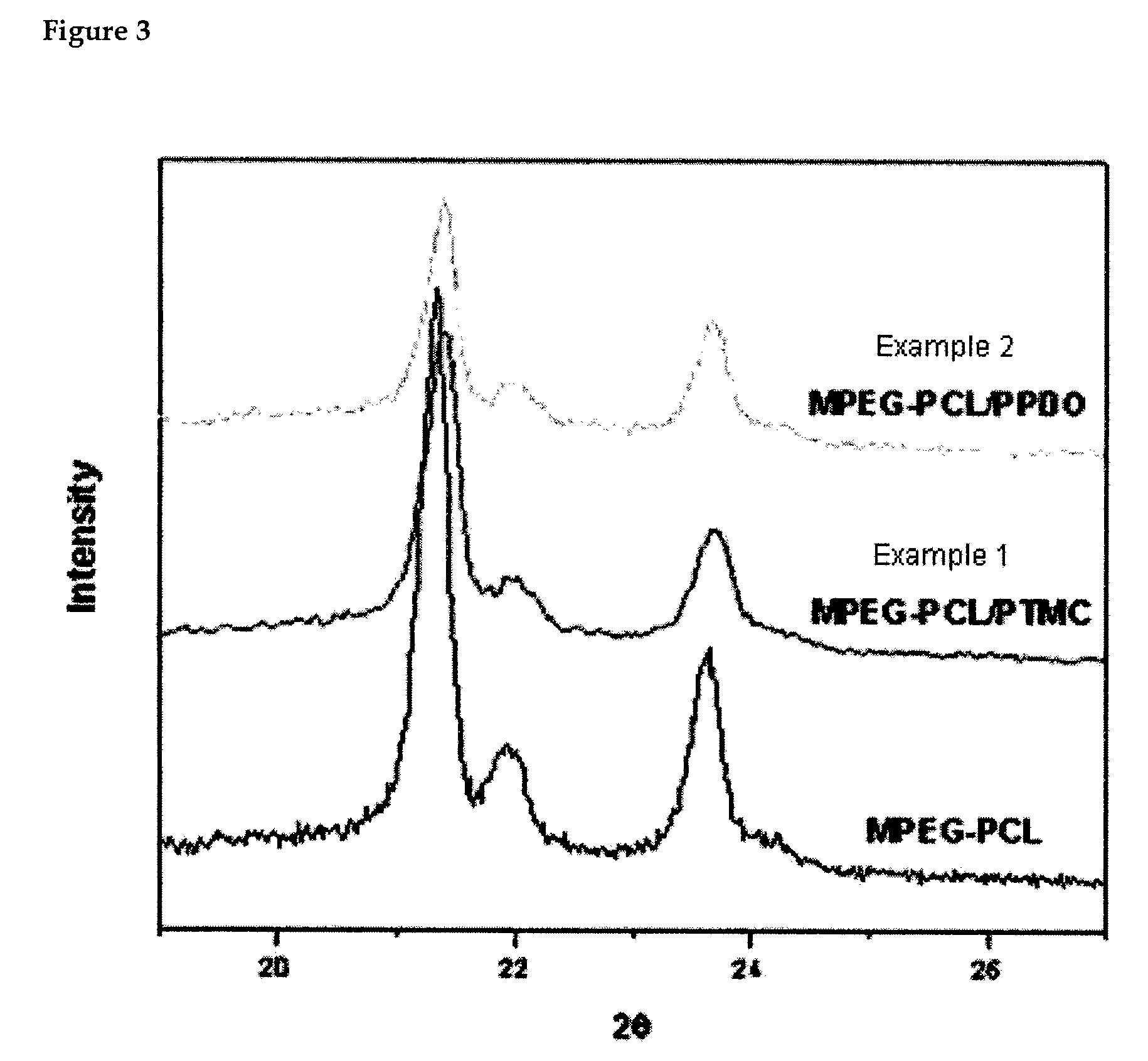Preparation and characterization of polyethyleneglycol/polyesters as biocompatible thermo-sensitive materials
- Summary
- Abstract
- Description
- Claims
- Application Information
AI Technical Summary
Benefits of technology
Problems solved by technology
Method used
Image
Examples
example 1
Preparation of methoxypoly(ethylene glycol)-(polycaprolactone-co-polytrimethylene carbonate) Block Copolymer [MPEG-PCL / PTMC]
[0033]For preparing MPEG-PCL / PTMC block copolymer having a molecular weight of 3,150 g / mole, 1.7 g (2.26 mmol) of methoxypoly(ethylene glycol) (MPEG) as an initiator and 80 mL of toluene were placed in a well-dried round flask (100 mL), and an azeotropic distillation was performed for 3 hours at 130° C. using a Dean-Stark trap. After the distillation, toluene was completely removed, and methoxypoly(ethylene glycol) (MPEG) was cooled down to room temperature. 5.15 Gram (2.26 mmol) of pre-distilled caprolactone (CL) and 0.27 g (2.25 mmol) of trimethylene carbonate (TMC) were added, and 25 mL of pre-distilled methylene chloride (MC) was also added as a reaction solvent. After 4 mL of HCl was added as a polymerization catalyst, the solution was stirred for 24 hours at room temperature. All the steps were performed under high purity nitrogen. After the reaction was ...
example 2
Preparation of methoxypoly(ethylene glycol)-(polycaprolactone-co-polypara-dioxanone) block copolymer [MPEG-PCL / PPDO]
[0035]For preparing MPEG-PCL / PPDO block copolymer having a molecular weight of 3,150 g / mole, 1.67 g (2.24 mmol) of methoxypoly(ethylene glycol) (MPEG) as an initiator and 80 mL of toluene were placed in a well-dried round flask (100 mL), and an azeotropic distillation was performed for 3 hours at 130° C. using a Dean-Stark trap. After the distillation, toluene was completely removed, and methoxypoly(ethylene glycol) (MPEG) was cooled down to room temperature. 5.11 Gram (2.24 mmol) of pre-distilled caprolactone (CL) and 0.38 mL (2.24 mmol) of para-dioxanone (PDO) were added, and 25 mL of pre-distilled methylene chloride (MC) was also added as a reaction solvent. After 4 mL of HCl was added as a polymerization catalyst, the solution was stirred for 24 hours at room temperature. All the steps were performed under high purity nitrogen. After the reaction was completed, to ...
example 3
Measurement of Sol-Gel Phase Transition Behavior of poly(ethylene glycol) / biodegradable Polyester Block Copolymer as a Function of Time in an Aqueous Solution
[0037]To observe the phase transition behavior of poly(ethylene glycol) / biodegradable polyester copolymer as a function of temperature, each of the synthesized copolymer was dissolved in distilled water into the concentration of 20 wt %, and cold-stored at 4° C. for a day to maintain the equilibrium of uniformly dispersed polymer. The sol-gel phase transition behavior of thus prepared polymer solution was measured with a viscometer by elevating the temperature (1° C. per 3 minutes) from 10° C. to 55° C. at a fixed spin rate of 0.2 rpm (FIG. 5).
PUM
| Property | Measurement | Unit |
|---|---|---|
| temperature | aaaaa | aaaaa |
| molar ratio | aaaaa | aaaaa |
| molar ratio | aaaaa | aaaaa |
Abstract
Description
Claims
Application Information
 Login to View More
Login to View More - R&D
- Intellectual Property
- Life Sciences
- Materials
- Tech Scout
- Unparalleled Data Quality
- Higher Quality Content
- 60% Fewer Hallucinations
Browse by: Latest US Patents, China's latest patents, Technical Efficacy Thesaurus, Application Domain, Technology Topic, Popular Technical Reports.
© 2025 PatSnap. All rights reserved.Legal|Privacy policy|Modern Slavery Act Transparency Statement|Sitemap|About US| Contact US: help@patsnap.com



